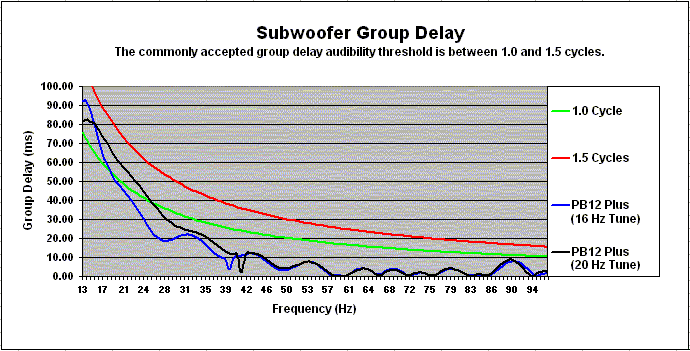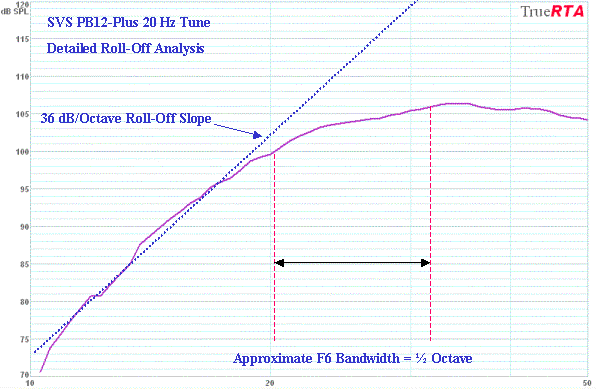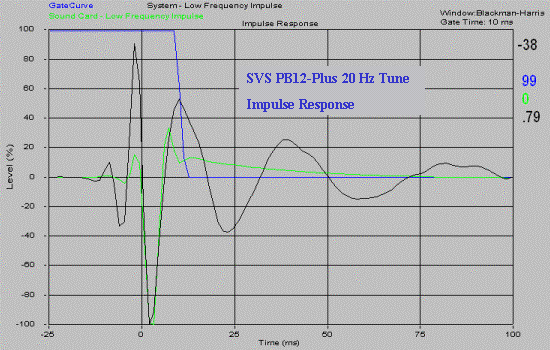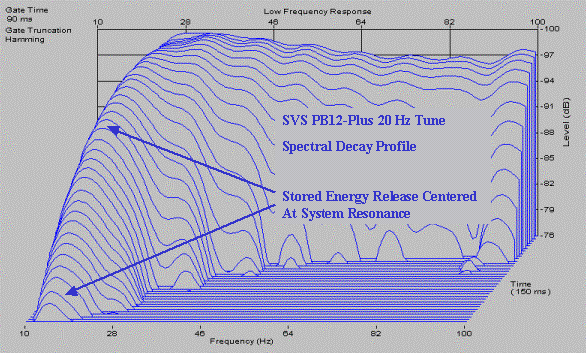Group Delay Calculation
A sufficiently large and abrupt phase shift may
cause the perception of time smearing at the affected frequencies. Group
delay is used to quantify this phenomenon, and is essentially the derivative
of phase with respect to frequency. The commonly accepted audibility
threshold for group delay is between 1.0 and 1.5 cycles for any given
frequency.
The PB12-Plus holds group delay below
1 cycle down to 26 Hz (18 Hz for the 16 Hz tune), and it never exceeds 1.5 cycles. In addition, the GD curves
show a smooth and steady rise (normal behavior for a bass reflex subwoofer),
with no abrupt changes.
Holding GD below 1 cycle across nearly the entire bass music spectrum is a
good achievement for a bass reflex subwoofer, and this is due to the very
deep tuning frequencies of the PB12-Plus. Enthusiasts can therefore expect
“on-time” sound delivery from this subwoofer.

System Ringing and Stored Energy Release Test
The amount of system ringing
and stored energy release exhibited by a subwoofer is a function of its
acoustic alignment and roll-off profile. A subwoofer with a narrow F6
bandwidth and a steep roll-off will ring longer and release more stored
energy than will a subwoofer with a wider F6 bandwidth and a shallower
roll-off profile. Regardless, most subwoofers will ring anywhere from 25 ms - 150
ms at system resonance. Similar to group delay, the audibility of system
ringing and stored energy release is frequency dependent. The deeper it
occurs, the less likely it will be noticeable on music and movies.
Due to the 2nd order high pass filter (designed to help protect the woofer
from over-excursion below the tuning frequency), the PB12-Plus has a fairly
narrow F6 bandwidth and a 36 dB/octave roll-off slope. It rings for about
150 ms (using a –25 dB test floor) as shown below on the impulse response
figure. And as illustrated in the spectral decay chart, this ringing occurs
at/near system resonance, which is either 20 Hz or 16 Hz depending on the
selected subwoofer tune.
Because the PB12-Plus system ringing and energy release only occurs at very
deep frequencies, listeners can expect a tight sound with no overhang.
Readers should bear in mind that the listening room itself has a very large
influence on perceived tightness, and that room treatments and bass traps
can often remedy excessive overhang.



Click Here to Go to Part V.